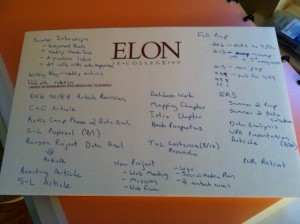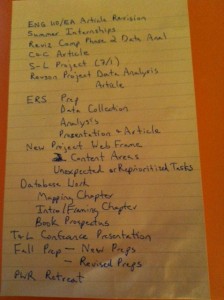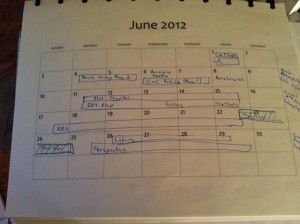After a stressful academic year (yes, even with a sabbatical this spring), I’m looking forward to a rejuvenating summer. I need to recharge so that I can successfully tackle some new opportunities and energize myself for what promises to be a very busy fall. Yet I also want to make progress on some scholarship projects before that busy fall semester starts. To achieve both goals, it’s time to inventory my summer goals, prioritize them, map them on a calendar, and cut what doesn’t fit.
My Goal Inventory
During the academic year, I go through a lot of sticky notes to plan my writing goals for the week and to make daily to-do lists that forefront those goals. Planning for the summer requires a bigger sticky note, but it’s still helpful to use a limited physical space to add some perspective to how many goals I reasonably can accomplish. For that reason, I usually start my summer goals brainstorming on an 8.5″ x 5.5″ notepad. (My university recycles outdated letterhead as notepads; if you don’t mind a banner logo or contact information on a small portion of the paper, the notepads are great for brainstorming activities.) I list every research project, writing project, service project, and course prep activity I’d like to accomplish during the summer if I had an unlimited amount of time. I don’t always list sub-steps for these goals, but if I know the goal has multiple parts that each will require significant time, I list those pieces.
The initial list usually isn’t very realistic… Especially since it doesn’t reflect any “down time” – hiking, fishing, gardening, and all the other things I do to de-stress!
Prioritizing Goals
In take two, I use a smaller pad (~4″ x 6″) that’s lined, and I limit myself to one item per line:
With this second version, I begin to prioritize. If I’ve already committed to other people to complete a project, it goes on the list. If a task has strong connections to priorities in my five-year career plan, it goes on the list. If it’s an unrelated might-be-interesting-to-do item that I can’t directly connect to my longer-term goals, it gets cut.
Finally, at this stage, I also look for relationships. If a presentation can serve as an invention or drafting activity for an article, I pair them on my list as a reminder to keep the presentation focused in ways that scaffold the writing project. In this summer’s example, I also took a line for the unexpected tasks that I anticipate will come up with a new project that’s still a bit undefined; until I know more about the timeline and parameters, I need to reserve some extra time for it.
Realistically, this list is still too long for a balanced summer, though, so I’ll make one more pass and number the items to indicate my top priorities – and my lower priorities. At this point, I start to make judgement calls: One item might not connect as strongly to my current career goals, but if it wraps up a previous project and will only take a few hours, it will be high priority since I like bringing closure to projects when they’ve run their course. If I’m receiving any type of summer stipend or other compensation for a project, it will be a high priority. And if a project has the potential to be career-defining if well executed, it will be a high priority.
But the prioritized list of goals still doesn’t account for time to recharge…
Mapping Goals
The next step, then, is to map my prioritized goals on a calendar. Tanya Golash-Boza wrote today about “How to Have a Productive Summer by Working Four Hours a Day,” and I like the spirit of her post. If I were working only on scholarship and fall course prep during the summer, I likely would implement a similar plan. This summer, though, I’m responsible for organizing a research seminar and launching a new project, and both tasks require significant time commitment. As a result, I plan to work full days…
But I’m committed to confining my summer work projects to working hours so that my evenings are free for other things: exercise, gardening, play time with my dog, etc. I’m also blocking weekends so that – with the exception of the seminar week and a conference – work doesn’t seep into that time. Finally, I also scheduled a week-long trip to visit family.
After I define those boundaries, I start plugging in my prioritized goals:
At this point, I begin to estimate how much time I’ll need for specific tasks related to my summer goals, and I try to group goals in ways that will increase my chances for successfully reaching them. For instance, in the June calendar above, I’ve paired data analysis and writing for related projects in the same week so that I don’t have to shift gears multiple times; I’ve also scheduled the tasks to correspond to due dates to which my collaborators and I committed. For a later week, I’ve visually mapped two projects in a way that signals to me that one will be a morning project for the week, while the other will be an afternoon project – after I’ve taken a lunch break that involves leaving my work space.
Once I run out of space on the calendar, it’s time to make some tough cuts. Prioritizing the goals first, though, helps me more quickly decide which goals I’ll have to save for a future semester and summer. While it’s hard to let things go, it’s better to recognize at the start of the summer that I can’t accomplish everything than to be disappointed at the end of the summer.
One other critical step in this mapping project is that at the end of each week, I list my primary goal(s) for the week in the margin. These goals will transfer to my writing goals sticky-note for the week and will help me stay focused as other odds and ends come up.
Final Tips
I hope that my extended description of my own summer goal setting demonstrates that planning for 2.5 to 3 months requires time and reflection to be effective. When you are ready to set your own summer goals:
- Set aside time to brainstorm and refine your goals; you’ll need more time than you allocate for weekly goal setting. You essentially are establishing a semester work plan for the summer, so give yourself at least 30 minutes (if not a full hour) to map your plan.
- Brainstorm your goals. Now that the academic year is wrapped up, you probably have a stock-pile of would-like-to-dos and when-I-have-more-times. Include them in your initial brainstorming so that you have time to reflect on where they fit within your current career priorities.
- Refine and prioritize your goals. Your criteria might be different than mine depending on your career stage and other factors. But take time to articulate why some goals are more important at this point.
- Map the tasks associated with your high priority goals on your summer calendar. I start with a blank, printed calendar, but electronic calendars work well too (and in some programs you can use calendar layers to associate tasks with specific goals). Don’t forget to map your “recharge” time before you fill your calendar with work goals.
- Use your calendar to guide your weekly goals and daily to-do lists, but also allow some flexibility. I actually build in a catch-up week to allow for the unexpected – whether it’s work-related or home-related.
Finally, leave time at the end of the summer to reflect on what you accomplished!
What strategies do you use when you’re setting summer goals?


